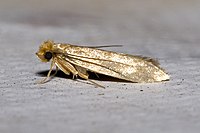
Photo from wikipedia
In the present work, 3,3′-(butane-1,4-diyl)bis(1-methyl-1H-imidazol-3-ium) dichloride ([C4(MIm)2]·2Cl) and 3,3′-(butane-1,4-diyl)bis(1-methyl-1H-imidazol-3-ium) hydrogen sulfate ([C4(MIm)2]·2HSO4) were prepared via adequate, solvent-free methods and characterized using FT-IR, 1H NMR, 13C NMR, and potentiometric titration techniques.… Click to show full abstract
In the present work, 3,3′-(butane-1,4-diyl)bis(1-methyl-1H-imidazol-3-ium) dichloride ([C4(MIm)2]·2Cl) and 3,3′-(butane-1,4-diyl)bis(1-methyl-1H-imidazol-3-ium) hydrogen sulfate ([C4(MIm)2]·2HSO4) were prepared via adequate, solvent-free methods and characterized using FT-IR, 1H NMR, 13C NMR, and potentiometric titration techniques. These reagents were investigated in the synthesis of 5-arylidene (thio)barbituric acids, 2-arylidene malononitriles, 4H-pyrans, and pyrano[2,3-d] pyrimidineones, and their catalytic activities were compared in the promotion of these reactions. Based on the obtained results, we found that [C4(MIm)2]·2Cl showed more catalytic efficiency where a basic or weak acidic media is needed. In contrast, [C4(MIm)2]·2HSO4 is a powerful catalyst in reactions needing acidic catalysts to enhance the reaction rate. Using these reagents, the products were formed under mild and eco-friendly conditions in excellent yields during short reaction times without needing column chromatography for work-up.
Journal Title: Research on Chemical Intermediates
Year Published: 2019
Link to full text (if available)
Share on Social Media: Sign Up to like & get
recommendations!